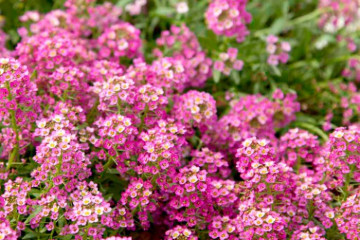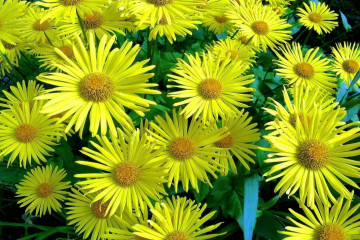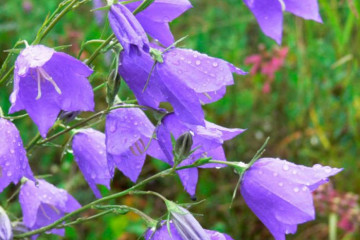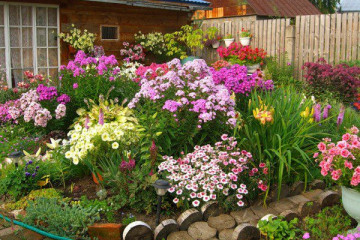Alstroemeria flowers
Content:
Alstroemeria is a popular flower among florists and exotic lovers on the site. This is a perennial herb that arrived in Russia from South America. It belongs to the Alstroemeria family. This flower is appreciated for its beauty, unpretentiousness and the fact that it can not fade for a long time, being in a bouquet. Otherwise, it is called the Peruvian lily. When caring for alstroemeria, as a rule, there are no difficulties, and it can be propagated both by seeds and by dividing the rhizome (bulb).
What does alstroemeria look like: description

Alstroemeria: growing and care
Alstroemeria are flowers very similar to lilies. They are distinguished by fusiform roots and tall stems. Small linear leaves are located throughout the stem, but they are more concentrated at the top.
A feature of such a plant is considered resupation - the leaf stalks are twisted, which is why their lower part is located on top, and the upper part is below. This makes alstroemeria even more unusual.
Astralmeria flowers can be colored pink, scarlet, purple or even lemon. They can be both monochromatic and multi-colored - for example, in the middle the flower can be yellow, and at the ends of the petals - crimson. There are also dark longitudinal stripes on the petals. Alstroemeria has six lanceolate petals, they are located three pieces in two circles. The stamens are located in the same way and have elongated anthers.
There are more than a hundred varieties of alstroemeria - among them, the most common varieties are:
- Virginia - white alstroemeria, has large flowers blooming from June to November. The height of the stem is about 70 cm. The plant is very fond of the sun.
- Harmony - differs in bronze flowers with pronounced dark strokes on the stems. Stems up to 160 cm, strong. It blooms in spring and autumn until frost.
- Regina is a tall variety, the stems grow up to 2 m. Alstroemeria is pink, blooms in spring and autumn.
- King Cardinal - the variety is distinguished by the presence of high peduncles in flowers. Loves an abundance of light. Alstroemeria is red, blooms from April to the onset of autumn cold weather.
- Beauty - stems up to 170 cm, powerful. Alstroemeria is purple, it can have a lilac hue. Sometimes you can see blue flowers. Such alstroemeria bloom in spring and autumn, in September.

Alstroemeria can be of different colors: from white to purple
Alstroemeria: planting and care in the open field
To understand how to grow alstroemeria, you should start by purchasing plant seedlings. You can grow it from seeds, but for this you have to work hard, and it will begin to bloom only after a few years.
It is recommended to plant ready-made seedlings in open ground in May, when the warm weather becomes stable, and frost will definitely not happen. The soil should warm up to at least 20 ° C. The seedlings should be planted at a distance of 40-50 cm from each other, the holes should have a depth of about 30 cm.
To prevent the plant from rotting from an excess of moisture, it is recommended to pour a little expanded clay or crushed stone at the bottom of the hole.A layer of compost is placed on top for plant nutrition. The rest of the hole is filled with soil and watered.
The area where alstroemeria is planted must be protected from the wind. She needs a lot of sun throughout the day. Light partial shade from nearby bushes and trees is recommended so that the rays of the sun do not burn the delicate leaves and petals of the plant.
Reproduction of alstroemeria
You can propagate the plant yourself using seeds or by dividing the rhizome.
Seed propagation
It can be difficult for inexperienced gardeners to grow alstroemeria from seeds, since certain conditions must be created for the seedlings to germinate and the seed material must be prepared.
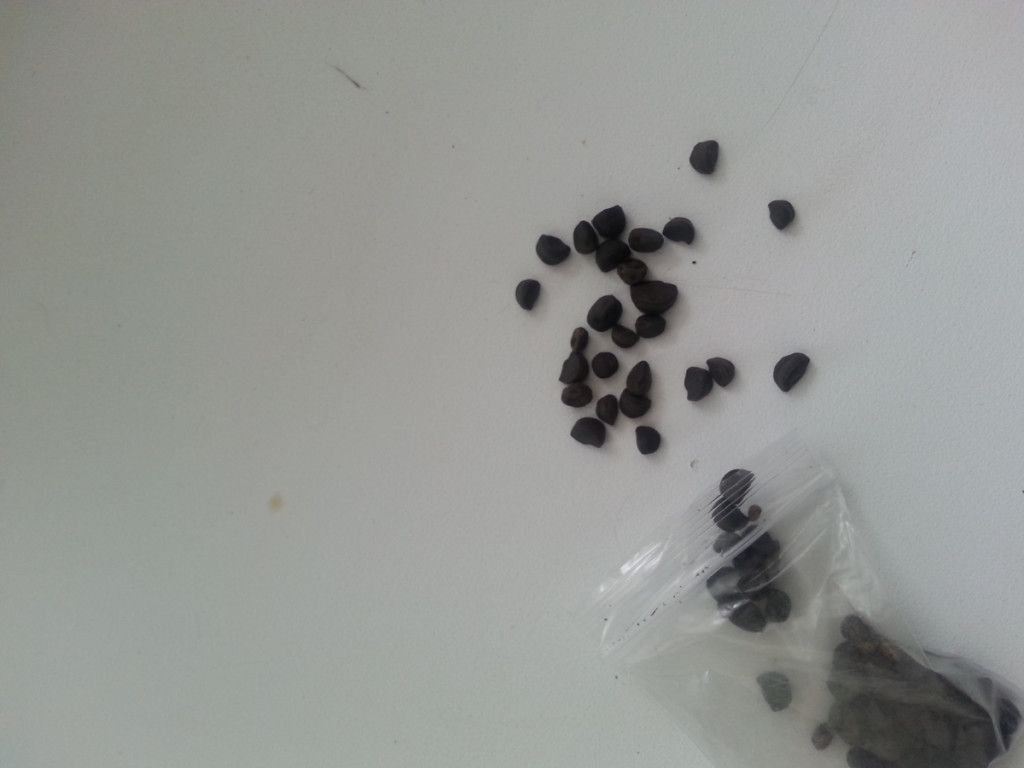
Alstroemeria seeds
You can purchase seeds or collect them when the flower pod is just cracked. You can wrap it loosely with gauze so that the seeds do not crumble to the ground.
The collected seeds need to be stratified - so their germination rate will be higher, they will germinate faster. First, they are placed in a damp cloth or gauze, and then in the refrigerator for a month.
Sowing seeds is recommended at the end of February in small containers. You can use peat cups. You need to place the seeds in the substrate only by 1 cm. The containers should be covered and placed in a place where the temperature is +17 .. + 21C. Shoots will appear a month later.
You can do a pick after the appearance of three leaves. It is necessary to plant the resulting seedlings in open ground in May, but the first buds will appear only after 1-3 years.
Reproduction by dividing the rhizome
So it is worth propagating hybrid varieties - new plants will bloom in the current or next year. It is important to do division after flowering.
It is important to carefully dig up the bush. The roots need to be slightly cleaned of the soil, and then divided into 2 or 3 parts, depending on the size. Places of cuts must be treated with charcoal or a special solution for disinfection. New flowers must be planted immediately after dividing.
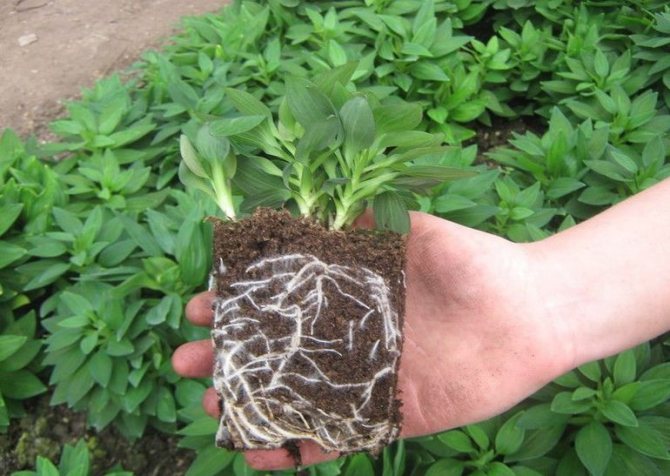
Plant rhizome
Leaving during flowering and dormancy
Although alstroemeria is an unpretentious flower, it needs some care for growth and flowering.
Temperature regime
During the period of rest and preparation for the flowering of alstroemeria, a temperature of about + 15 ° С at night - + 13 ° С is required.
For the development of seedlings, building up the root system and flowering, a temperature within the range of +21 .. + 23 ° С is more suitable.
It is important that when growing in a greenhouse, the temperature does not drop below +8 ° C, otherwise the plant will freeze.
Watering
Often there is no need to water alstroemeria - in case of heavy rains, additional watering is not required, in their absence, watering once a week is sufficient.
The soil should be slightly moist, but the plant does not like excess water: the roots can rot. If there is little moisture, alstroemeria can stop blooming and die altogether.
The soil
Sandy or clayey soil is more suitable for such a flower than heavy soil. The acidity of the soil should be between 6.5 and 7 pH. If the pH is more than 7, you can reduce the acidity by adding peat or substrates that are sold in specialty stores.
The soil near the roots should be mulched so that they do not overheat - otherwise the flowering of the plant will be damaged. The soil around the flower should be covered with a layer of compost, manure, leaves or grass 3 cm thick. Thanks to it, the weeds near the alstroemeria will grow worse, the soil will be more nutritious, and the roots will be protected.
Top dressing
For abundant flowering, you need to fertilize the bushes 3-4 times a month from spring to autumn frosts. What matters is what is included in the fertilizer: it must contain both phosphorus and nitrogen. Thanks to them, flowers and leaves will be large and bright.
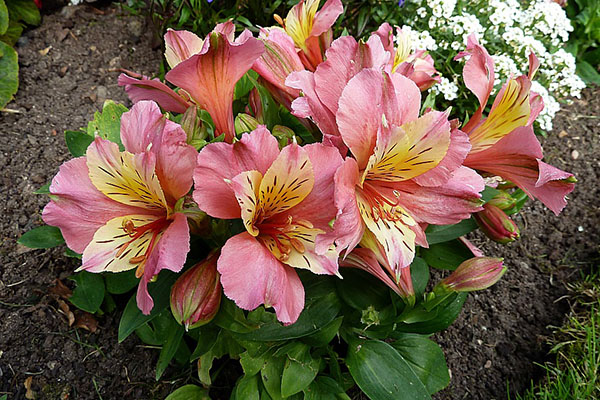
You need to feed alstroemeria several times a month
Preparing for winter
Flowering of different varieties of alstroemeria occurs from spring to autumn frosts. When the flowers of alstroemeria wilt, for further cultivation, they must be carefully removed, and the bushes themselves must be thinned so that they are not too thick and do not take a lot of strength and nutrients from the plant. Thin and weakened stems must be removed, and all healthy ones must be shortened.
In order for alstroemeria to successfully survive the winter, it is covered with spruce branches, a film, and then soil and humus. So the roots will not die from frost. Annual varieties do not need to be protected from frost in any way - in any case, they will not bloom next year.
If the cultivation of alstroemeria occurs at home, special preparation for the cold is not needed: it is only important to observe the temperature and light conditions. For this you can use phytolamps.
Diseases and parasites

You can fight diseases and parasites with drugs
Alstroemeria is resistant to both parasites and disease, but with proper care. Watering it too much can cause it to develop gray mold. Its distinctive characteristic is the appearance of a fluffy coating. Immediately after the appearance of such a problem, alstroemeria must be treated: the affected parts are removed, and healthy ones are sprayed with a fungicidal preparation. If the plant is too badly affected, it is better to dig it up and destroy it to protect the bushes growing nearby.
If the bushes are not looked after, spider mites and caterpillars can appear, which will quickly destroy them. To get rid of it, you will have to use acaricides and insecticides.
Astramerias, or alstroemerias, attract with their beauty: they can decorate the garden all summer or be used for bouquets that can be placed in a vase. Bridal bouquets made from alstroemerias and violets also look good. They will bloom every year, without requiring special care: it is enough to feed them on time, water them and monitor the condition of the soil, as well as protect them from parasites.
